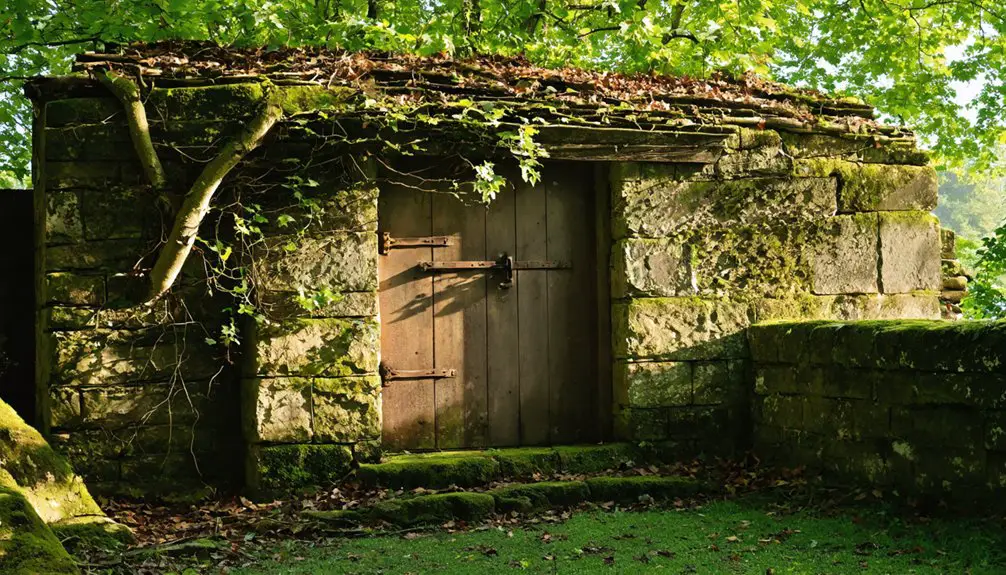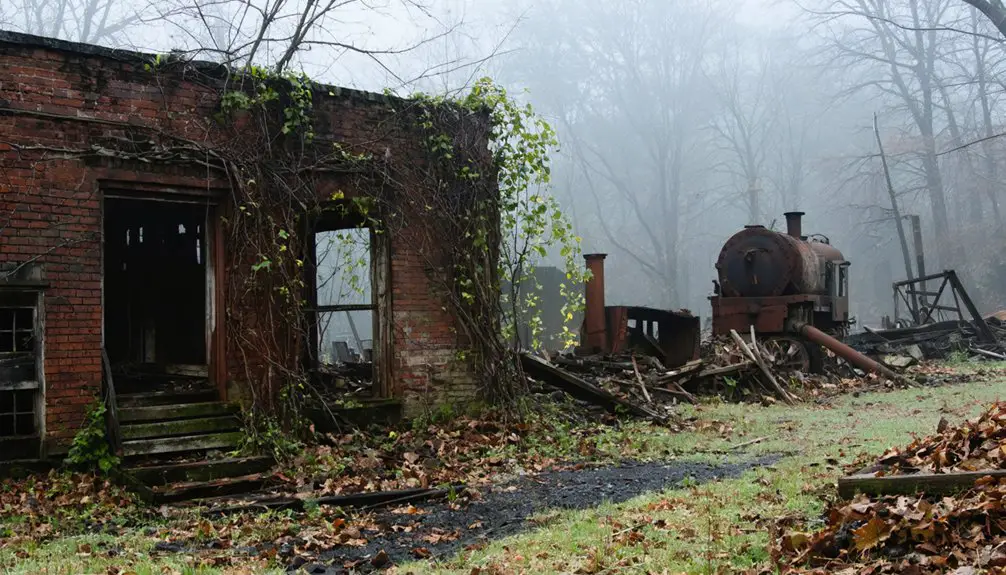You’ll find the ghost town of Bagdad along the Kiskiminetas River in Armstrong County, Pennsylvania’s Gilpin Township. This former industrial powerhouse emerged in the mid-1800s as America’s third-largest salt producer before shifting to coal mining. The Pennsylvania Railroad and canal system fueled its growth, supporting 35 families with essential amenities like blacksmith shops and a schoolhouse. Today, stone foundations and deteriorating infrastructure tell the story of this once-bustling community’s rise and decline.
Key Takeaways
- Bagdad, Pennsylvania became a ghost town after early 20th-century mine failures and fires caused economic migration and community decline.
- The abandoned town’s archaeological remains include stone foundations of miners’ homes, deteriorating canal infrastructure, and ruined coke ovens.
- Once America’s third-largest salt producer and thriving industrial hub, Bagdad supported 35 families with local amenities before its decline.
- Located along the Kiskiminetas River between Schenley and Leechburg, Bagdad served as a crucial transportation hub for canals and railroads.
- The town’s desertion exemplifies the boom-and-bust cycle of American industrial communities dependent on mining and resource extraction.
The Rise of a Canal-Side Mining Village
While Pennsylvania’s industrial landscape was shaped by countless mining towns, Bagdad emerged as a distinctive settlement along the Kiskiminetas River, positioned strategically between Schenley and Leechburg in Armstrong County’s Gilpin Township.
You’ll find that before urban decay set in, this canal-side village thrived on its prime location near “Wherry’s Defeat,” where community resilience was tested during the challenging construction of essential riprap walls.
The village’s evolution accelerated when the Pennsylvania Railroad built its branch from Leechburg to Schenley in the late 1880s, connecting Bagdad to critical coal regions.
With about 35 families calling it home, the settlement boasted a blacksmith shop, one-room schoolhouse, and local stores that served the salt and coal miners who’d become the backbone of this industrious community. The area became renowned for its lucrative salt production operations run by prominent manufacturers Daniel Hill and Kistler.
Salt Production and Coal Mining Heritage
As Pennsylvania’s salt industry flourished in the mid-19th century, Bagdad distinguished itself as a premier salt-producing settlement along the Kiskiminetas River.
You’ll find the legacy of salt mining in the deep wells that reached 250-300 feet below ground, where crews extracted valuable brine. The process wasn’t easy – it took 30 gallons of brine to produce just one bushel of salt. Early settlers had relied on salt from Liverpool before local production began. Like the Pennsylvania Salt Works of 1776, many early operations faced severe production challenges.
The painstaking process required extracting brine from deep underground wells, with each bushel of salt demanding 30 gallons of brine.
What made Bagdad’s operations particularly efficient was the discovery of coal during well drilling. This fortunate find provided ready fuel for the furnaces needed in salt production.
The village thrived as families like the Kistlers, Clines, and Walters engaged in both salt mining and coal extraction. By 1830, the region had become America’s third-largest salt producer, though competition from Louisiana eventually ended operations by 1882.
Transportation Hub: Canal and Railroad Convergence
Bagdad’s strategic location along the Kiskiminetas River made it an ideal transportation nexus where the Pennsylvania Canal system met emerging railroad networks.
You’ll find evidence of remarkable transportation innovations in the area’s infrastructure, including massive retaining walls and the integration of canal boats with railroad flatcars.
The site’s critical position, just four miles above Schenley and two miles below Leechburg, helped overcome significant logistical challenges in moving goods between Philadelphia and Pittsburgh.
The Western Division Canal, with its complex system of 68 locks and 16 aqueducts, connected to the Allegheny Portage Railroad at Johnstown.
This engineering marvel reduced travel time between major cities to just 3-5 days, revolutionizing the movement of coal, salt, iron, and textiles throughout Pennsylvania’s industrial corridor.
Wooden aqueducts carried boats across rivers and valleys, showcasing the innovative engineering solutions of the era.
The transition to railroads became inevitable as steam engine advancements by 1850 made locomotives increasingly efficient for transporting bulk goods.
Life in a 19th Century Industrial Town
During the height of Pennsylvania’s industrial revolution, Bagdad exemplified the archetypal 19th-century factory town, where life revolved around a complex interplay of work, community, and technological advancement.
You’d have found a diverse industrial workforce living in row houses and twin homes within walking distance of the factories, with immigrant laborers from England, Ireland, and Germany forming the backbone of the community. Local Catholic parish boundaries helped define and shape the neighborhood’s distinct cultural identity. These early manufacturing settlements were strategically positioned near rivers and canals for reliable power and transportation.
The town’s layout reflected the era’s practicality, combining manufacturing zones with residential areas and commercial districts. While factory owners exercised considerable control over daily life, they often provided community amenities like parks and cultural institutions.
You would’ve witnessed the introduction of modern conveniences too – electric power arrived in the 1880s, transforming both work and home life in this bustling industrial settlement.
Social Fabric and Community Bonds
You’ll find that Bagdad’s social cohesion centered around two key institutions – its ecumenical church that welcomed all Christian denominations and its local bars, Ravotti’s and Anderos.
The church served as a unifying force through Sunday school and Bible storytelling by figures like Wilda McKallip, while the bars provided essential spaces where salt workers could gather and share stories about their experiences and local history. The village was home to approximately 35 families during its peak in the 1940s and 1950s.
These complementary social hubs created a tightly knit community where religious practice and worker solidarity intertwined, forming the backbone of Bagdad’s social fabric. Much like the remarkable 767 days without rain recorded in the town’s history, the resilient spirit of the community persisted through challenging times.
Church Unites Local Faiths
The resilient church in Bagdad, Pennsylvania served as a unifying force that transcended denominational boundaries throughout the early 20th century.
You’ll find that interfaith collaboration flourished as the church hosted joint worship services and religious festivals, creating a space where different Christian denominations could practice their faith under one roof.
The church’s influence extended beyond religious services through community gatherings that strengthened social bonds. The discovery of a 1987 yearbook suggests ongoing youth and educational programs were vital to community life.
When financial challenges arose in the 1940s, parishioners united to overcome mortgage debt.
During times of crisis, you’d witness the church functioning as a sanctuary, coordinating mutual aid and providing emotional support.
It’s remarkable how this institution adapted to serve diverse religious customs while maintaining its role as a central meeting place for spiritual guidance and social connection.
Bars Foster Worker Bonds
Steam rose from coffee mugs and beer glasses at Ravotti’s and Anderos Bar, where Bagdad’s industrial workers found solace after grueling shifts in the mines and salt works.
These establishments weren’t just watering holes – they were essential community gatherings where workers shared stories of triumph and hardship, building lasting bonds that extended beyond the workplace.
You’d find miners and salt boilers engaged in animated discussions, preserving storytelling traditions that spanned generations.
They’d recount tales from both World Wars, share updates on local developments, and discuss the challenges of industrial life.
Through games of boccie ball and informal networking, these bars created an atmosphere where workers could find mutual support and understanding.
The venues served as unofficial archives of Bagdad’s rich history, strengthening the social fabric that held this industrial community together.
Engineering Marvels and Natural Challenges
If you’d visited Bagdad during its heyday, you’d have witnessed one of the era’s most impressive engineering feats: the massive riprap wall constructed between the canal towpath and the Kiskiminetas River.
The wall’s initial construction faced devastating setbacks when the “tears” of Old Kiski River destroyed months of work, creating the locally infamous “Wherry’s Defeat” named after contractor James Wherry.
Through determination and advanced engineering techniques, workers successfully rebuilt the riprap wall, which stood as a reflection of 19th-century infrastructure innovation and enabled crucial transportation for the region’s coal and salt industries.
Canal Construction Innovations
Pioneering canal construction near Bagdad, Pennsylvania showcased remarkable engineering innovations that transformed America’s early transportation infrastructure.
You’ll find examples of tunnel advancements near Blairsville, where engineers drove through Bow Ridge to create shorter routes, bypassing challenging geological obstacles and reducing travel time considerably.
The canal’s aqueduct structures were equally impressive, carrying boats over streams and rivers while maintaining continuous water flow below.
These engineering marvels used stone and timber construction, creating the striking visual of boats floating mid-air.
You’ll notice the extensive riprap and retaining walls that protected the canal’s infrastructure from flood damage – a critical concern at Bagdad, where river floods once destroyed months of work.
These innovations demonstrated American ingenuity in overcoming natural challenges through advanced engineering solutions.
River Control Methods
Throughout Pennsylvania’s industrial development, river control engineering emerged as a critical challenge that demanded innovative solutions.
You’ll find that engineers tackled river management through multiple approaches, from wing dams that concentrated flow to create deeper channels, to extensive lock and dam systems that transformed unpredictable waterways into reliable transportation corridors.
The engineering challenges were particularly evident in incidents like “Wherry’s Defeat” at Bagdad, where flooding destroyed riprap walls designed to protect navigation infrastructure.
Yet these setbacks led to more robust solutions, including the implementation of slackwater systems that created calm water reservoirs.
Riprap Wall Challenges
While constructing riprap walls along Pennsylvania’s waterways presented significant engineering challenges, the precise arrangement of well-graded rock sizes proved vital for structural integrity.
You’ll find that successful riprap stability demanded careful selection of stones, from large to small, creating an interlocking structure that could withstand powerful hydraulic forces.
The Kiskiminetas River demonstrated nature’s devastating impact when flood events destroyed months of work at Bagdad’s canal wall, including James Wherry’s ill-fated construction attempt.
To combat these natural forces, engineers learned that proper gradation, measured by the median dimension d50, was essential. This specification guaranteed that half the rock volume remained larger and half smaller, optimizing the wall’s filter properties and resistance to water pressure while minimizing dangerous voids between stones.
Economic Forces Behind the Exodus
As the Pennsylvania Railroad extended its branch line to connect Leechburg and Schenley in the late 1880s, Bagdad’s economic destiny became inextricably linked to coal mining.
You’d find high-quality Freeport vein coal under almost every acre of Gilpin Township, making the area a prime target for mining operations.
When the mines began failing in the early 20th century due to fires, collapses, and decreasing demand, you couldn’t stop the domino effect of economic migration that followed.
The town’s single-industry dependence meant that as mining jobs disappeared, everything else crumbled too. Local stores, bars, and churches lost their patrons.
Even farmers who’d supplemented miners’ tables with milk and produce watched their markets vanish. The community decline was swift and merciless as families sought work elsewhere.
Architectural Remnants and Historical Sites

Today’s visitors to Bagdad can still trace the ghostly outlines of its mining heritage through scattered architectural remnants.
Like many Pennsylvania ghost towns, you’ll find foundations and partial structures that hint at the town’s bustling past. The ghost town remnants reflect typical 19th-century construction methods using local timber and stone, similar to other mining communities of the era.
- Stone foundations mark where miners’ homes once stood in neat rows along narrow streets
- Canal architecture remains visible through deteriorating infrastructure that once supported the town’s commercial activities
- Scattered industrial remnants, including ruined coke ovens and mining structures, showcase the durable masonry construction methods of the period
The site’s layout follows patterns you’d recognize from preserved mining towns like Eckley, with buildings strategically positioned for efficient access to work areas.
Notable Families and Local Leaders
You’ll find that Bagdad’s most influential families made their fortunes in the local salt industry, with the Hills, Lynches, and Kistlers emerging as leading manufacturers along the Kiskiminetas River.
The Kistler family, particularly Daniel, Samuel, and John, established some of the region’s richest salt wells, while other families like the Clines, Stulls, and Walters contributed to the booming salt economy.
These salt industry pioneers shaped Bagdad’s development through their economic leadership, employing many residents as salt boilers and miners during the village’s peak period.
Salt Industry Pioneers
During the heyday of Bagdad’s salt industry, several prominent families and local leaders emerged as pioneering forces in the region’s economic development.
You’ll find that Daniel Hill and David Lynch stood out as influential salt production managers, with Lynch continuing operations until the industry’s final days in 1882. Despite growing industry competition from Louisiana and western regions, these determined pioneers maintained their operations as long as possible.
- The Kistler family dynasty, including Captain Samuel and his brother John, played pivotal roles in shaping the local salt works.
- B.B. Ashbaugh and H. Wray represented the final generation of salt entrepreneurs, leasing operations from Rowan.
- Local families like the Clines, Stulls, Shusters, and Walters contributed to the broader salt-making community, establishing Bagdad’s reputation as a significant salt-producing hub.
Mining Family Legacies
The rich tapestry of Bagdad’s mining heritage was woven through generations of dedicated family enterprises, with the Nulph family emerging as a cornerstone of the community’s industrial backbone.
Through their blacksmith shop, James Nulph and his relatives “Birdie” and “Bunny” supported mining innovations by maintaining essential tools for the industry’s survival.
You’ll find other influential families who shaped Bagdad’s industrial landscape, including the Kistlers, who pioneered salt manufacturing alongside Daniel Hill and David Lynch.
The Clines, Stulls, Shusters, Sherbondies, Shirys, Klingensmiths, and Walters demonstrated remarkable family resilience while contributing to both mining operations and community development.
James Wherry’s determination in completing the Pennsylvania canal’s retaining wall exemplified the leadership that kept Bagdad’s industrial dreams alive.
Legacy in Pennsylvania’s Industrial History

As Pennsylvania’s industrial landscape evolved through the late 19th and early 20th centuries, Bagdad exemplified the essential role of coal-mining communities in powering America’s industrial revolution.
The historical narratives of this now-vanished town reveal a story of community resilience amid industrial transformation.
You’ll find Bagdad’s lasting impact reflected in three key areas:
- Its strategic position along rail and canal routes made it a crucial link in Pennsylvania’s coal distribution network.
- The town’s rise and fall mirrors the broader pattern of industrial boom-and-bust cycles that shaped America’s economic development.
- Its archaeological remains serve as a tangible reminder of how coal towns fueled the nation’s industrial growth.
Today, while Bagdad exists only in memory, its legacy endures as a tribute to Pennsylvania’s pivotal role in American industrialization.
Frequently Asked Questions
What Happened to the Remaining Residents After Bagdad Became a Ghost Town?
Like leaves scattered by autumn winds, you’d find the remaining residents relocated to nearby towns with better jobs, while others maintained loose community impact through occasional cemetery visits and storytelling.
Were There Any Major Accidents or Disasters in Bagdad’s Mines?
While you’ll find records of historical accidents in Bagdad’s mines, there weren’t any major disasters documented. Mine safety concerns were common, with typical incidents involving falls, machinery, and minor explosions.
What Was the Peak Population of Bagdad During Its Most Prosperous Years?
Like many mysteries lost to time, you’ll find no exact records, but during its peak economy around 200-500 people likely called it home before the inevitable population decline began.
Did Native Americans Have Any Settlements in the Bagdad Area Before?
While there weren’t permanent settlements directly in Bagdad, you’ll find evidence of Native settlements in nearby Atteques village at Schenley. Cultural artifacts suggest indigenous peoples used the Kiskiminetas Valley for hunting and travel.
What Types of Artifacts Have Been Found at the Bagdad Site?
You’ll find artifacts discovered include mining tools, architectural remains, household items, and mysterious carved stones. Coal-related remnants and military bunkers hold significant historical significance to the area’s industrial past.
References
- https://www.pa-roots.com/armstrong/beersproject/history/chapter18.html
- https://www.youtube.com/watch?v=VBXkSWc-es4
- https://www.gilpintwp.com/history.html
- https://www.youtube.com/watch?v=yxFuqGq-FJ8
- https://archive.triblive.com/news/woman-shares-sounds-sights-of-bagdads-past/
- https://en.wikipedia.org/wiki/Gilpin_Township
- https://www.pa-roots.com/armstrong/beersproject/history/chapter14.html
- https://www.alleghenyfront.org/pittsburgh-city-of-steel-or-salt/
- https://www.pennsylvaniaresearch.com/pennsylvania-salt-industry.html
- https://philadelphiaencyclopedia.org/essays/salt-making/



